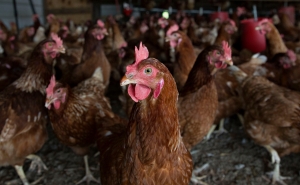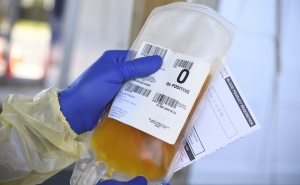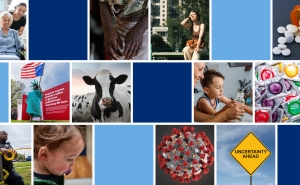COVID-19 Vaccines: Verifying Safety and Identifying Misinformation

How do we know COVID-19 vaccines are safe?
With vaccines starting to roll out across the US, what can we expect to see in the coming weeks and months? How do we know that these vaccines are safe? And, with so much misinformation circulating, how can the average person separate fact from falsity?
Medical anthropologist Monica Shoch-Spana, PhD, MA, and immunology expert GiGi Gronvall, PhD, from the Johns Hopkins Center for Health Security answer questions about COVID-19 vaccines.
Pfizer and Moderna vaccines have been cleared for emergency use authorization, and there are other promising vaccines in the works. What can we expect to see in the coming weeks and months with those other candidates?
Gigi Gronvall: There are so many vaccine candidates in some stage of development—over a dozen, actually, that are in phase 3 trials—but only a few are going to be for the U.S. market. I think we'll continue to see more data released and some more emergency use authorization requests.
I think that's when we're going to start being able to compare some of the vaccine candidates. All of them have had higher efficacy rates than we were expecting. So it's been mostly an all good news story. But the timetable depends on when the companies get enough data to support an application to the FDA.
We’ve already seen health care workers and some priority groups get vaccinated. What will happen next?
Monica Schoch-Spana: You may have a safe and effective vaccine, but the question still remains, Who gets it, and in what order? The Advisory Committee on Immunization Practices is charged with recommending to the CDC an answer to that very question.
Health care personnel already started getting access [to vaccines] in mid- to late-December. On their heels will be essential workers outside of the health sector, persons with high-risk underlying medical conditions, and elderly individuals.
It's important to understand who constitutes “health care personnel.” The advisory committee is defining health care personnel as all paid and unpaid persons serving in health care sectors who have the potential for either direct or indirect exposure to patients or infectious materials. Right now that category is approximately 20 million people, and it includes personnel at hospitals, long-term care facilities, pharmacies, emergency medical services systems, and also outpatient facility staff. All of these folks are essential for the ongoing COVID response, and they are also at a higher risk for exposure to the novel coronavirus.
How do we know that the vaccines that may get emergency use authorization from the FDA are safe?
GG: There are different phases of conducting a clinical trial. I referred to these vaccines as being in phase 3 trials. This is the last phase where people are looking at safety and efficacy. The first phase is purely [for] safety. It's [tested on] a small group of people to make sure that the vaccine [is] well tolerated. And in the second phase, they get a little bit more into the safety part and what kind of doses are required.
It's really only in the third phase that we're looking at whether the vaccine actually does the job that we're hoping it will do, which is to prevent people from getting sick. Thousands of people have gotten these vaccines—at this point, some of the trials have had 30,000 people. That is not enough. There is still a need for more data because this is a vaccine that will go to millions of people. So the FDA will still be requiring the collection of safety data as we go forward. But right now, amongst the thousands of people who have had the vaccines, [they’ve] had a good safety record.
“Vaccine efficacy” refers to how well a vaccine performs in a trial setting. Some of the vaccines are showing 95% efficacy. Does that mean that 5% of people who are vaccinated would still get COVID?
GG: There's a lot of different ways that people calculate efficacy. Think about it as if you were vaccinated and your friend was not vaccinated, and you were both exposed to the same amount of virus. Your risk of coming down with COVID is 95% reduced compared to your unvaccinated friend.
Some other vaccines offer 50% efficacy. When you think of it in those terms—if you have a 50% reduced risk of coming down with disease [compared to] an unvaccinated person exposed to the same amount of virus—it's still a pretty good risk calculation for yourself.
But 95% is amazing. That's more like the efficacy that we see for childhood vaccines—diphtheria, MMR, tetanus, or measles.
Since it may take some time to get a large percentage of the population vaccinated, will we continue to be using some precautions like masks and social distancing into this summer and possibly the fall of next year?
MSS: That's a great question because it points to the need for all of us to be both hopeful about the promise of vaccines, but also realistic about the time-consuming efforts that are going to be involved with distribution and administration. We need to, all of us, set realistic expectations, while not losing a sense of resilience and hope.
In order to enable a full recovery from the pandemic, we have to think about all the tools in our prevention toolkit. That includes vaccines, but it's not limited to vaccines. All of us have been doing a good job with washing hands, wearing masks, and physically distancing ourselves from others, while also assessing indoor air quality and how well ventilation is working.
We need to use all of those tools even once a vaccine becomes available. The vaccination enterprise [is] a large system with a lot of players, a lot of steps, and a lot of responsibilities that are distributed from national levels all the way down to local municipalities.
We are looking at an ongoing rollout from manufacturers as their capacity allows, and we will face ongoing rollout as far as distributing that product. And then ongoing administration where vaccinators are actually administering the vaccine to individuals and groups of individuals.
Each aspect of that system takes time. So it's important that all of us pitch in with every tool in our tool kit. While vaccination is unfolding across the nation, we should all be prepared to continue to wear masks to continue to wash hands and to continue to physically distance ourselves and avoid larger gatherings.
There is misinformation circulating that COVID-19 vaccines contain mercury, anti-freeze, animal blood, or even formaldehyde. What’s behind these claims?
GG: COVID vaccines are new, but these kinds of concerns about vaccines go back for a long time. These are often intentionally a misconstruction of information by people who are anti-vaccine.
Do they include animal blood? Do they include formaldehyde? No, they don't. There are some chemicals that sound similar to some of these. There's a mercury cousin called thimerosal that was used in vaccines in the past but that's barely used in vaccines now—not because of any safety concerns from the data, but mostly because of concerns that were raised by misinformation. Some [vaccines] do have preservatives, but all of them have been tested many times and have a good safety record, particularly in the quantities that are in the vaccine. A lot of times, people forget that we ourselves are made up of chemicals, and some of these things in the vaccine, there are sometimes more of them in your own body naturally.
It's important to be aware of your sources of information about the vaccine and also to recognize that there are groups—and some of them are nation-state funded—that are intentionally poisoning the information atmosphere with things that are not true about the vaccine. Some of the nation-state actors don't really care about vaccines and are not really “anti-vaccine.” They're just really trying to sow discord.
A good hint of whether the information comes from a source that's intending to sow discord is if it makes you angry, if it inspires a powerful emotion. Just take the next step and look at your source. See if [the information] is coming from a place where there are people who are experts in that topic, who can address the concerns but without trying to manipulate you.
I've even heard [the claim] that there was some sort of chip in the vaccine—that is not possible and not something that is in these vaccines.
How do we know that what we’re seeing now is an alarming increase in the spread of the coronavirus and not just a result of better testing?
GG: Testing to see if somebody is currently infected with COVID is one tool that we have. When a place is doing a lot of tests, you can look to see what the test positivity rate is.
If 60% of all the tests that a particular state is doing are positive, that's an indicator that there are [a lot more] cases out there that they're not detecting, [and] they're not doing enough testing. A test positivity rate of under 5% [means] you're capturing most of the people who are positive.
Another indicator that COVID is increasing in most parts of the country is that we're seeing a big increase in hospitalizations and increases in deaths. We're getting better at treating patients, but nonetheless, you're seeing increases [in deaths].
There's a myth that injecting an RNA vaccine into your body could alter your DNA. Can you explain why this is not possible?
GG: The way that things work in your body is that you have DNA, which is your [genetic] blueprint, and then you have proteins that are made from RNA. When you inject an RNA vaccine, proteins will be made from that RNA, but it doesn't do anything to your DNA.
What are the side effects associated with COVID-19 vaccines?
MSS: When you get vaccinated, your immune system is responding to the introduction of materials and learning how to deal with the pathogen of concern—in this case, the SARS-CoV-2 virus that causes COVID-19 disease.
Some common side effects are fever, sore arms, and muscle ache. Those are typical signs that our bodies are reacting to the vaccine, and, rather than a sign of sickness, they are a good signal that our immune system is beefing itself up.
It's important that people be prepared for some potential soreness, maybe a little fever, maybe some muscle ache, maybe some fatigue. This is really important because, at least right now, the vaccines are two-dose vaccines. Some people may hesitate to come back for a second dose if they have a negative experience with that initial vaccine. So, we need to recognize that there are some normal side effects, and they mean that our immune systems are thankfully being turned on and learning what they should learn.
People will have to be sure to follow up with the second dose, because that's what's really going to secure the level of protection needed.
Why does this vaccine have what sounds like more notable side effects than the flu or other vaccines?
GG: The flu vaccine is very well tolerated—more than many other vaccines, I think. COVID vaccines are described as being a little bit more like the shingles vaccine. All of [the vaccines for different viruses] have a little bit more of these side effects than the flu vaccine does.
There will be some follow-up after you get the vaccines to make sure that you're doing well. We will need to make sure that medical providers are prepared to address any concerns after you get a vaccine.
There's also something called the Vaccine Adverse Event Reporting System, which is one of several reporting systems that you can take advantage of to make sure that if you're concerned about your symptoms, it’s brought to somebody's attention. There are a lot of different systems in place to try to capture this information.
Is it possible that COVID-19 vaccines will be made mandatory by the federal government?
MSS: No. Vaccines will not be made mandatory by the federal government.
This is another opportunity to implore that people make sure that they are checking on the sources of their information and verifying the truth of what they're hearing. It's important for people to understand that public health is best served by the behaviors of all members of society, and public health as a practice is driven by respect for people's autonomy and their individual rights. That means providing for high levels of health literacy and providing meaningful information so people can make informed decisions, and then allowing people to opt out of an intervention after they've gotten the information they need.
In the United States, there's a history of a sense of rugged individualism. I think we're all primed to get a little anxious around the sort of public health declarations about an intervention to curtail the pandemic. That's just part of our social fabric in the United States.
But again, some groups are interested in taking advantage of that ethos in our country and sowing misinformation about vaccines [being] mandated by the federal government because they are trying to drive a wedge between citizens and the government that is trying to protect their health and well-being.
Gigi Gronvall, PhD, is a senior scholar at the Center for Health Security and an associate professor in Environmental Health and Engineering.
Monica Schoch-Spana, PhD, MA, is a senior scholar at the Center for Health Security and a senior scientist in Environmental Health and Engineering.
RELATED CONTENT
Facebook Live Q&A
This article has been adapted from a November 25 Facebook Live Q&A





